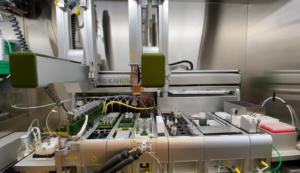By Francois Ricard – Executive Director, R&D, Lonza Advanced Synthesis

Introduction: The Rising Complexity of Small Molecule Development
![]()
 The development of small-molecule therapeutics has never been more complex. Pharmaceutical researchers are faced with molecules with higher molecular weight and increasing 3D character. At the same time, regulatory expectations are rising, market competition is intensifying, and patient needs demand more rapid development timelines. In this context, leveraging early-phase, data-driven strategies is essential for accelerating drug development while mitigating risk.
The development of small-molecule therapeutics has never been more complex. Pharmaceutical researchers are faced with molecules with higher molecular weight and increasing 3D character. At the same time, regulatory expectations are rising, market competition is intensifying, and patient needs demand more rapid development timelines. In this context, leveraging early-phase, data-driven strategies is essential for accelerating drug development while mitigating risk.
Once a target molecule has been identified, determining an optimal synthetic route as early as possible can help ensure long-term process feasibility and reduce overall risk. By integrating advanced tools from the earliest stages of development, drug developers can not only identify synthetic routes more quickly but also incorporate real-world data into route design. Modern approaches allow researchers to comprehensively explore possible synthetic processes, determining the most efficient, scalable, and reliable route before substantial resources are invested in preclinical or clinical manufacturing.
Synthetic processes that perform well in the lab may present challenges when scaled to preclinical or commercial volumes. For instance, a high-yielding reaction may be safe at laboratory scale, but scaling it for commercial production introduces significant safety and regulatory challenges, requiring specialized controls and equipment. By keeping downstream needs in mind from the outset, pharmaceutical developers can avoid costly process adjustments and delays during later stages of development.
Designing Smarter Routes: AI-enabled route scouting
Retrosynthetic analysis is a foundational step in small-molecule development. While traditional methods focus on identifying the shortest, most reliable route, modern approaches consider additional constraints such as raw material availability, cost, and scalability.
 Lonza’s Advanced Synthesis Business Platform integrates AI-enabled computer-aided synthesis planning (CASP) with real-world supply chain and pricing data. This approach allows drug developers to assess routes not only for theoretical efficiency but also for process feasibility and economic viability beyond the lab. Predictive insights into pricing and supply chain reliability enable researchers to anticipate potential disruptions due to geopolitical tensions, natural disasters, or raw material shortages, mitigating risk before scale-up.
Lonza’s Advanced Synthesis Business Platform integrates AI-enabled computer-aided synthesis planning (CASP) with real-world supply chain and pricing data. This approach allows drug developers to assess routes not only for theoretical efficiency but also for process feasibility and economic viability beyond the lab. Predictive insights into pricing and supply chain reliability enable researchers to anticipate potential disruptions due to geopolitical tensions, natural disasters, or raw material shortages, mitigating risk before scale-up.
By incorporating these tools early, emerging biotech companies can increase readiness for IND (Investigational New Drug) applications. Evaluating routes comprehensively before clinical and commercial manufacturing also minimizes risks during later-stage process development.
Accelerating Development Through Experimentation and Data
Once potential synthetic routes are identified, researchers must optimize process chemistry. High-throughput experimentation (HTE) allows many reactions to be conducted in parallel under varying conditions, providing rapid insights into optimal reagents, solvents, and reaction parameters. This approach reduces time, effort, and resource requirements compared to traditional iterative trial-and-error methods.
HTE requires specialized expertise, robotics, and analytical instruments. Lonza’s dedicated robotics system enables automated, round-the-clock experimentation across a wide range of reaction conditions. By conducting small-scale reactions in 96-well plates and scaling promising options to 20 mL, researchers gain comprehensive insights into reaction kinetics and scalability. For highly potent APIs, specialized glovebox and purge systems allow safe experimentation under low-moisture, low-oxygen conditions.
HTE accelerates the development of robust synthetic routes while mitigating scale-up risks, in particular when combined with AI route scouting.
Statistical Design of Experiments and Design2Optimize™
Optimizing process chemistry requires understanding how multiple variables interact. Traditional methods of changing one variable at a time fail to capture these interactions. Statistical Design of Experiments (DoE) is a well-established method that provides a structured approach to evaluate multiple parameters simultaneously, identifying critical process parameters (CPPs) that may influence yield, purity, and stability.
Lonza’s proprietary Design2Optimize™ platform extends DoE principles by integrating existing experimental data with physicochemical modeling. This reduces the number of experiments required to optimize reactions while providing predictive insights into complex chemistries. Researchers can model the impact of temperature, pH, and other parameters, creating a digital twin of the synthetic process. This enables exploration of hypothetical scenarios, such as adjusting process conditions to maximize yield, but also the multi-objective optimisation of parameters vs multiple targets without additional experimental work (e.g. aiming to achieve a sweet spot for yield and cycle time).
Solid Form Screening
Solid form selection is a critical early-phase decision, often sitting on the critical path to IND with profound downstream implications. The physical form of an active pharmaceutical ingredient (API), including salts, polymorphs, hydrates, solvates, and amorphous solid dispersions (ASDs) can impact solubility, stability, and bioavailability. Early identification of the optimal solid form ensures consistent performance, regulatory compliance, and intellectual property protection.
Salts or crystal coformers are, for example, often used to improve the bioavailability of poorly soluble compounds. However, the robust selection of the appropriate solid state requires extensive solid form screening, including evaluation of stability, solubility, polymorphism, etc. Failures at this stage can lead to significant delays, as evidenced historically by drugs like ritonavir, where solid-state issues required costly reformulation and regulatory approval.
Lonza’s approach to solid form screening integrates automated workflows and high-throughput capabilities, allowing multiple solid forms and formulations to be assessed simultaneously. This comprehensive strategy ensures that the most promising candidates are identified early, reducing downstream risk and accelerating the path toward clinical development. In particular, Lonza has recently enhanced its toolbox with a new AI enhanced conformer selection tool enabling the identification of the most likely co-formers for any API. This predictive approach can significantly reduce the number of experiments by guiding screen design and enhance probably of success of identify of suistable solid state form of the API in record time.
Understanding Behavior in the Body: Physiologically Based Biopharmaceutics Modeling (PBBM)
Once a stable and bioavailable solid form has been selected, understanding how the molecule behaves in vivo is the next step. PBBM offers a powerful predictive tool to simulate how a drug will distribute, metabolize, and eliminate in humans. Unlike traditional PK studies, PBBM integrates physiological, chemical, and biochemical data to predict drug behavior across different populations, including pediatric and elderly patients, and under varied dosing conditions.
By incorporating absorption, distribution, metabolism, and excretion (ADME) data, PBBM can identify potential challenges early, such as food-drug or acid-reducing drug interactions. For example, in developing posaconazole ASDs, PBBM was used to predict in vivo performance, guiding formulation strategies and dosing regimens. Regulatory agencies increasingly recognize PBBM data in IND applications, underscoring the importance of these models in accelerating clinical readiness. Lonza is at the forefront of deploying PBBM modelling tools such as Gastro+ in the CDMO industry guiding our customers decision and derisking their assets by ensuring appropriate drug exposure.
Strategic Benefits for Biotech and Pharma
Integrating AI-enabled route scouting, HTE, Design2Optimize™, solid form screening and PBBM tools provides a holistic, data-driven foundation for drug development in early phase and forms the first wave of a digital design and optimisation toolbox being built at Lonza to enable our customers’ drug to reach the market faster. Key benefits include:
- De-risking early development: Identifying optimal routes, formulations, and process parameters early reduces the likelihood of delays during scale-up.
- Accelerating timelines: Faster process optimization and predictive modeling shorten the path to IND submission and clinical trials.
- Cost efficiency: By selecting commercially viable routes and formulations early, developers reduce potential losses from late-stage failures.
- Investor confidence: Robust, data-backed processes demonstrate maturity and reliability to potential investors and partners.
Looking Beyond Process Chemistry
With the remarkable growth in AI and predictive tools, Lonza’s integrated approach is being extended well beyond chemistry optimization.
In the optimisation area, the combination of high-throughput screening combined with learning tools like D2O, Bayesian optimisation or AI are driving a paradigm shift towards self-optimising platform in process development.
In the technology transfer and manufacturing areas, digital twins of synthetic processes already allow exploration of hypothetical scenarios and process modifications before experimentation. Insights gained early inform later-stage development, such as scale-up and commercial manufacturing, ensuring that processes remain robust, scalable, and cost-effective. The ability to offer full digital technology transfer and manufacturing capabilities from lab to plant beyond current MES and LIMS system is also opening a wide range of opportunities for acceleration and optimisation of manufacturing of pharmaceuticals.
Toward a Data-Driven Development Paradigm in Early Phase
The convergence of AI-enabled route scouting, HTE, model-based process optimization, solid form science and PBBM, is transforming small-molecule drug development. By adopting a data-driven, integrated approach, drug developers can accelerate timelines, mitigate risk, and improve long-term process reliability. This data/model driven scientific approach may appear counter intuitive in a field where speed and trials and error approaches have dominated for years. However, recent advances in early-phase tools and capabilities now make it possible to take a more insightful yet pragmatic approach to drug development, enabling faster progress by avoiding challenges such as poorly developed or convoluted processes and suboptimal solid-state selection.
Early-phase decisions are no longer isolated tasks; they are interdependent steps that shape the efficiency and success of later development. Lonza’s tools and expertise empower biotech and pharmaceutical companies to adopt a “right-first-time” mindset, ensuring that every decision from solid form selection to scale-up is informed, strategic, and resilient. As the complexity of small molecules continues to grow, this integrated approach provides a competitive advantage, supporting faster access to life-saving therapies while optimizing costs and timelines.
If you would like to learn more, join Francois Ricard’s presentation on Smarter Molecule Development: AI-Driven Tools and Model-Based Approaches in Early-Phase on Wednesday, October 29, 2025, from 2:30–2:55 PM (CET) in Hall 4.1 – 4.1L8, Manufacturing 5.0, or stop by our booth 5.1B76 to connect directly with our experts.


